by Winding Pathways | Mar 14, 2024 | 1080 Labyrinth Blog, Labyrinths, Reflections/Profiles, Uncategorized
Who Is Stargirl?
Stargirl taught us to notice…to care. You know Stargirl, the spritely, hippie-seeming girl in the Jerry Spinelli story of the same title who showed up at a high school, wrote notes to people, played the ukelele, was nice to everyone, and even cheered the other team’s successes. She turned typical high school life upside down. And, then, vanished.
We walk today in her spirit. Usually ground underfoot is stone-cold and rigid. But with this “winter that hasn’t been” mole humps yield underfoot. We pause by the bell of the Phoenix Harmony Labyrinth.
Cookie Monster has nibbled the rim of the waning Gibbous moon as it slips west. Guided by moon shadows we walk.
-

-
Teri blesses the labyrinth
-
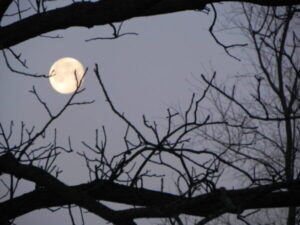
-
Tree branches help you watch the moon move across the sky.
From the south Mother West Wind shakes out the Merry Little Breezes. Off they skitter tickling the tops of the firs and rustling the winter-weary leaves of the Derecho-damaged oak.
Four Directions
Stop. Breathe in the air. Neither too cold nor too muggy. It’s Goldilocks. Just right.
To the east, a smear of red on the horizon separates the black earth from the velvet sky. Father Sun, starting to wake up, stretches his rosy fingers. Yet, stars still sprinkle the sky.
The ancient basswood tree full of gaping holes stands silhouetted. How did it survive when the sturdy oak shattered? Perhaps because it didn’t resist?
Totems
Vultures return in March. In fact, I saw one the other day soaring overhead. Checking out the basswood that has been home of vulture families for generations. Some people don’t like vultures because they are homely and eat dead stuff. Who among us is a Hollywood beauty?
As for eating dead stuff, good thing they do…One of Mother Nature’s cleanup crew. Otherwise, we would be knee-deep in rot. Maybe we are anyway. Good parents their keen eyesight and sharp smell lead them to meals which they feed their babies until they fledge.
Watching the young on their first flights as they swoop down, cross the labyrinth, then flap mightily to land in the fir on the far side is always a thrill. Vultures are good totems.
The pause by the birches feels like home. New England. Robert Frost wrote it well: “When I see birches bend to left and right Across the lines of straighter darker trees, I like to think some boy’s been swinging them. But swinging doesn’t bend them down to stay. Ice-storms do.”
Call and Response
Ahh, off in the woods a call and response as two cardinals awaken and call. A turkey gobbles from a tree top.
At the Center of the labyrinth, I thank the earth elements, plant and animal kingdom, those I have known. I send Grace to those I dislike, which helps me most. I stop and thank guides and Divine love.
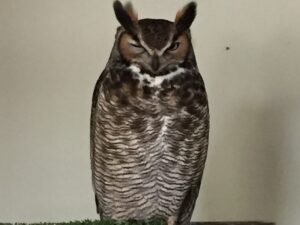
Injured owls find a safe home at the International Owl Center.
An owl floats past. Silent yet hearing, unseen yet seeing all. Quiet knowing. Carrying us through the night into the day.
To the north the Big Dipper’s handle swings off to Arcturus and look! A shooting star blazes brightly dropping into the North Star.
Stargirl is with us.
by Winding Pathways | Feb 8, 2024 | Birds, Nature
We live in a world of dizzying change in how we live, drive, and communicate. Like many people, we struggle to keep up with change and stay modern, so it’s comforting to know that some things simply don’t change. Fortunately, winter owls don’t change.
In March 1982 the Cedar Rapids GAZETTE printed Marion’s column on Iowa owls. It’s as relevant today as it was 42 years ago.
Audible In Winter
Now is the season of Winter Owls. The time of year when they are especially audible and often visible. Owls have a large vocabulary from courting to warning. YouTube is a great source to learn about and hear the sounds.
Barred and Great Horned Owls
We love hearing the clear and somewhat chilling calls of Barred and Great Horned Owls that reach our house over the snow and through the woods on clear, frosty winter nights. These two species live near our home year-round, with Barred Owls the most common. You can tell the Great Horned call that is low and throaty. The Barred calls out the familiar, “Who cooks for you?” refrain.
-
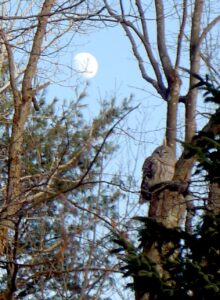
-
Waiting for supper.
-

-
Injured owls find a safe home at the International Owl Center.
Screech Owls
A few times a year we drive to New Jersey to visit relatives and often are delighted to hear the two calls of a local Screech Owl serenade the evening. Its soft, haunting trill, called a tremolo, wafts over the lake. The “whinny”, think of a horse whinny, is territorial.
Northern Owls
Several of our friends trekked north this winter to see Great Grey and Northern Hawk-Owls. The Great Grey’s sound varies from a low-pitched “whoof” to an abrupt “meeh” to short screeches similar to a blue jay. The Northern Hawk Owl’s vocabulary ranges from high-pitched warbling sounds that carry across frozen landscapes to “chit-chit-chits” to a wimpy, scratchy screech. Think of a person with laryngitis trying to sing. All owls’ calls are amazing delights for those who wander outside and listen carefully on winter evenings.
-
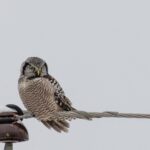
-
Northern Hawk Owl on wire. Photo Mark Ogden
-
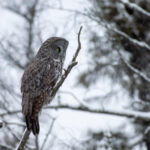
-
Great Gray Owl visits Northern Minnesota. Photo Mark Ogden
Snowy Owls
Many owl species don’t migrate much but these two sometimes dip southward from their usual winter range. So do magnificent Snowy Owls. In some especially frigid winters, they drift way south in what’s called an “irruption”. Birders flock to see them in open fields and even on the edge of airports! One of our favorite owls is the tiny Northern Saw-Whet Owl. They regularly come south in winter. Years ago, the Indian Creek Nature Center had a thick grove of young pines, a winter habitat the bird loves. Often, we could approach them closely on cold days. We even heard them once in the tiny ‘pine grove’ at our former residence.
How Do I Love Thee?
A fascinating aspect of owls is that they court and nest when it’s still winter! Although people rarely see courtship or mating, it is fascinating. Texas Backyard Wildlife captured video and the offering to the bigger female as a token of Love.
What prompts these impressive raptors to court, breed, and endure the hardships of incubating eggs in nature’s most desolate time of year? Necessity! Baby owls are a lot like human babies. They take a lot of care. For months owlets cry, eat, sleep, and poop. All the while growing. Just like humans. Young hatch late March into April when small rodents, the mainstay of owls, become more plentiful. Then, the adults really get busy foraging to feed the young tucked into nests of sticks.
Nests
Unlike some birds, Great Horned owl nests are not works of art. Adults return to the same wood tracts year after year and add only a few extra twigs. Young, like many teenagers, can make a shambles of the nest. The more practical Screech Owls prefer tree cavities and can be convinced to nest in wooden boxes adapted for them.
Parenting
During winter owls can be noisy and obvious as they wing across snowy fields at dusk. But after courtship and nesting, they quiet down. Like human adults, they are busy raising the young. By mid-summer people sometimes find “teenaged” owls flopping around on the ground or perched precariously on low branches. Like all fledglings, they are learning to fly. It’s best to leave them alone. The parent is nearby and the “kids” will make it without our help.
-
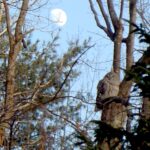
-
Waiting for supper.
-
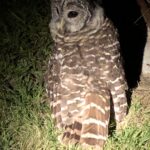
-
Grounded.
Tuck In and Read!
Winter is more than a time to hear and see owls. It’s a season to read about them. Our two favorite bird magazines featured owls in their winter 2024 editions. BIRD WATCHER’S DIGEST, features a species profile on Barn Owls. LIVING BIRD includes a fascinating article called HUNTING BY HEARING. The magazines are available online to subscribers. We enjoy both while curled up with the paper copy by the wood stove, and occasionally reading online articles. We also browse reliable internet sources and YouTube videos on owls.
Be Intrepid!
For intrepid winter visitors a trip to the International Owl Center in Houston, MN, is a delight. Their signature event, the International Festival of Owls is scheduled for March 1-3 this year.
-
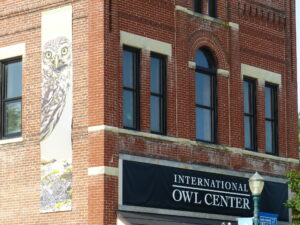
-
All things owl.
-
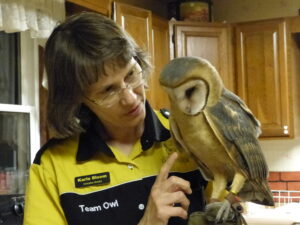
-
The International Owl Center promotes owl awareness.
Enjoy Winter
It’s winter. A season to enjoy the cold, snow, and OWLS.
by Winding Pathways | Jan 25, 2024 | Nature, Reflections/Profiles
Lots to Experience in January
(reworked from the Patterson’s “Iowa’s Wild Side” column
originally in the Cedar Rapids Gazette)
Winter in Iowa is erratic. Mild. January thaws. Grey, damp, and achy mornings. Frigid. Blustery. Sunny, sparkling days when all is right. We have it all. Here are ways we a find joy in January.
Some people escape to warmer regions. Most of us hang tough and grumble. At Winding Pathways, we’ve found that simple observations can enliven and deepen our appreciation for the change of seasons.
Sit Still
Bundled up in his Carharts and sitting quietly downwind at dusk, Rich notices deer begin to move. Stars and planets glow. Five geese honk and wing across the waxing moon. A photographer’s dream. An owl’s call fills the stillness left behind.
Wildlife freeze as the great horned owl’s ghostly shape floats silently to a branch near our home. Puffed to twice its size, a buffer against the cold, it waits. Several long minutes pass. Then, a rabbit cautiously emerges from the prairie stubble. An opossum noses hungrily at the compost heap. A startled mouse scurries across an open space. With talons extended and yellow eyes gleaming, the owl drops. After a brief scuffle, only bits of fur remain.
-
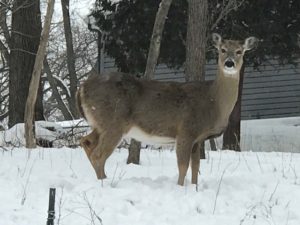
-
Inquisitive doe.
-
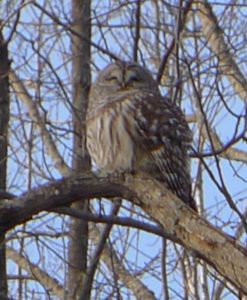
-
Waiting
-
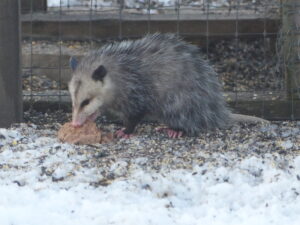
-
Possums’ feet help it climb.
Observe When You Drive
Another way we find Joy in January is by taking drives. Across a frosty Iowa road, we slow as four deer race across a field, leap a barbed wire fence, and dash to safety beyond busy Highway 30. We speculate what startled them. A short time later we observe a face-off between a grazing cow and a foraging hawk. Neck stretched out, nose to the wind, the cow eyes the hovering hawk.
From the comfort of our home, we watch birds. Siskins, when the weather is cold, Carolina wrens when winters are mild, hang around the feeder and shrubs loaded with berries. A red-headed woodpecker pecks at suet. It rattles noisily and jabs its lance-like bill at the less aggressive birds. Its strong bill is great for hammering insects out of frozen trees and pounding holes in ice-encased water baths.
January Ice
Black ice is another winter phenomenon. While not fun to drive on it is intriguing on rivers, ponds, and lakes. One Kansas winter an Arctic airmass plunged into the heartland and gave us a chance to peer into the dark depths below. A snapping turtle slowly swam through the thick water. Ice skaters reveled in the unusual event.
Nowadays we enjoy Arctic air from the inside. A small pool is just outside our window near the feeders. Sometimes, when temperatures drop quickly, and black ice forms we can see “through the looking glass” so to speak. A small aerator keeps a circle of water open. Small birds hop to the edge and drink. The overwintering goldfish appreciate the extra O2.
And we enjoy hot chocolate during January’s dormant month.
by Winding Pathways | Apr 16, 2020 | (Sub)Urban Homesteading, Garden/Yard, Nature, Pests
Lyme Disease is something you just don’t want. Rich has had it twice. It was no fun, and he was lucky. Nearly as soon as symptoms appeared, he visited our family physician. She prescribed a powerful antibiotic that worked wonders and left him with no lingering problems. Unfortunately, many Lyme Disease victims suffer pain and fatigue for years. It’s serious.
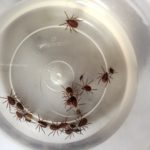
Collection of ticks
Lyme is often transmitted to a human from a bite by a tiny tick that picked up the disease bacteria from an infected white-footed mouse. It once was thought that deer were the primary carrier but mostly they are host to a tiny larval tick that infects a mouse that allows another tick to infect a person.
In theory, eliminating white-footed mice from a yard and home will greatly reduce the odds of transmission of this disease to people. Killing all of them isn’t feasible but reducing their numbers is.
About White-Footed and Deer Mice
White Footed and Deer Mice are amazingly common across much of North America. They’re the cute, native mouse, not to be confused with the common house mouse that originated in the Old World.
White Footeds naturally live in dry temperate forests with brush. That perfectly describes suburban landscaping. It’s likely that five to 20 white-footed mice live in close proximity to most suburban families. They’re nocturnal and rarely seen.
Here are some characteristics:
- They’re hoarders. Find a cache of corn, dog food, or acorns in a shoe or empty can and you’ve found a white-footed mouse cache.
- They reproduce like crazy. A 44-day old female can become pregnant and bear a litter after 22 to 28 days. Babies become independent in three weeks and soon begin having their own babies. Mom often has two to four litters a year.
- They don’t live long. A year-old mouse is elderly.
- Foxes, weasels, hawks, owls, coyotes, and many other predators love dining on mice.
- White Footed mice enjoy coming into homes, where they often find food and enjoy a furnace’s warmth. They can bring with them disease-bearing ticks.
Prudent homeowners carefully manage ticks, in part by reducing white-footed mice numbers. The fewer mice that live near people the lower the odds a person will contract Lyme Disease. So, managing mice and ticks makes for a healthier home and yard. Here are a few tips:
To reduce mouse populations and entry to homes:
- Welcome mouse predators. Karla Bloem, Executive Director of the International Owl Center says, “Two actions people can take to encourage owls are to protect large dead trees that aren’t a threat to people of buildings should they fall. Owls love them. Also, building and erecting an owl house can welcome owls to live near a home and catch and eat mice.” Barred owl nest box plans, and plans for many other birdhouses, can be found at www.nestwatch.org.
- Plug up holes that allow mice to enter a home and replace worn or broken weatherstripping. This is an important fall maintenance that also keeps cold drafts outside and reduces heating bills.
- Avoid feeding mice. They love dining on dog or cat food left in a dish overnight or birdseed left under a feeder. Only feed pets and wild birds what they can eat in a short time. Then, pick up and clean the pet bowl.
- Use snap traps to kill mice in the house. Avoid poison. A poisoned mouse can stagger outside to be caught and eaten by an owl, which can sicken or die from the poison.
A Few More Ways to Reduce Lyme Disease
In addition to reducing mouse numbers and applying a vaccine to keep survivors free of Lyme Disease bacteria here are a few other ways a person can do to reduce odds of infection:

Pants, boots, gaiters and insect repellents help protect from ticks.
Use Permethrin: When applied to clothing, not skin, this chemical repels and kills ticks. Rich purchased several sets of clothing from the Insect Shield Company that are impregnated with permethrin. Supposedly the tick-killing effectiveness lasts for 70 washings. The chemical is also available in spray cans to apply to any clothing.
Do Tick Checks: After being outside, strip down and check the body over for ticks. Then take a hot sudsy shower. Ticks usually crawl around on a person for several hours before biting. A tick merely walking on the skin can’t infect a person.
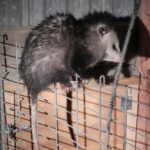
Opossums groom themselves carefully.
Thank and welcome opossums: New research indicates that opossums are tick vacuum cleaners. Ticks climb on them, but these primitive mammals groom often and eat the ticks they remove from their fur and skin. If you have a possum living in the yard be happy.
An Emerging Tool in the Battle Against Lyme Disease
A new product is being developed and tested by a major research company. It is an oral nontoxic vaccine placed in small baits. When strategically positioned around a yard, mice not yet infected with Lyme bacteria eat it and become resistant to the bacteria. Mice uninfected by Lyme can’t spread the disease to a person. If all goes well this product will be on the market by 2021 and may be a major help in reducing human cases of Lyme Disease.
Lyme Disease is an awful condition. Taking precautions to reduce the odds of being infected makes sense.
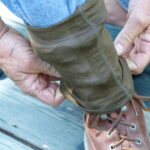
gaiters with tick guard help repel ticks.
by Winding Pathways | May 23, 2019 | Birds, Nature
A Tale of Baby Owls
Guest Blogger, R’becca Groff
The first sign of an owl living back on our acreage happened late last summer when I heard a rabbit being taken late one night. A rabbit sounds like a human baby when it’s in trouble, and it is the painful reality of the food chain.
Throughout this past winter, my neighbors and I have been listening to two owls living across our adjoining properties – a very large one and his smaller mate — we assumed.
I was the only one who wasn’t getting outdoors in time to see them, however.
The other day I heard the hooting midday and ran outside, determined to see where this owl was perched. It sounded so close to my office window. And there it was…staring down at me from one of the old Austrian pine trees between my house and my neighbor’s.
I spoke softly to it, hoping it wouldn’t mind but it wanted nothing to do with me, and promptly vacated its branch perch, gliding gracefully across my neighbor’s back yard to a safer distance.
As I’d been hearing about a huge hawk nest way at the back of our property line, I went to have a look for myself. Studying the tree line as I walked, I came upon an owlet watching down from one of the lower branches of another pine tree. I couldn’t resist it. I had to try and converse with this beautiful creature. It sat there watching back at me, unhinged by my presence. Just for fun, I circled the tree, and the baby followed my every move.
Of course, I texted the neighbors, only to learn there are two new owlets as my northern neighbors have been watching that hawk nest through binoculars. They’ve been observing as mama owl hunts and feeds these babies around dusk. She obviously is doing a fine job as we all have plenty of owl pellets on the ground around our trees.
Throughout the day I couldn’t keep away. I kept walking back out to view this new baby living in my yard. Later that day I finally caught a glimpse of its sibling perched near the top of the pine tree at the end of our acreage’s property line.
The neighbors and I had a chuckle, as we’ve noticed the rabbits seem to have moved across the street —
out of our yards!
-
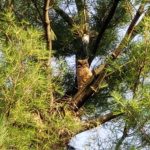
-
This owlet blends into the background of the pine bark trunk.
-
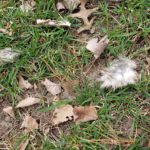
-
Look under trees for owl pellets.
-
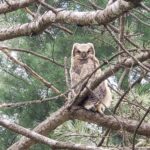
-
Fuzzy owlet




















